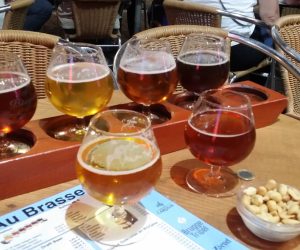The capital of Belgium, Brussels, is a multiethnic, energetic city that provides tourists with a wide range of activities and sights. The Grand Place and the Atomium are two examples of the city’s stunning design, and waffles, beer, and chocolate are just a few of its mouthwatering culinary offerings.
Brussels serves as the location of many institutions, including the European Commission and the European Parliament, as it is the legislative hub of the European Union. Visitors can visit the Parlamentarium, an interactive exhibit that examines the history and role of the European Parliament, as well as the EU Quarter to learn more about the operations of the EU.
Brussels has a rich cultural heritage and the city offers something for everyone. In this article, we will give you a list of a few of the things to do and see while visiting the city.
Visit the Grand Place
The Grand Place, also known as the Grote Markt in Dutch, is Brussels’ main plaza and a UNESCO World Heritage Site. Beautiful 17th-century structures in the Gothic and Baroque architectural styles encircle it. Tourists visiting Brussels must go to the Grand Place, which is regarded as one of the most stunning places in all of Europe.
Built in the middle of the 15th century, the Gothic-style Town Hall is the most impressive structure in the plaza. At the summit of its 96-meter-tall tower is a statue of St. Michael slaying a dragon. The plaza is a great place to unwind and admire Brussels because buildings that house restaurants, cafes, and stores surround it.
The Flower Carpet, a biannual celebration that sees the plaza covered in a vibrant carpet of flowers, is another notable event at the Grand Place. The Grand Place in Brussels is a must-see destination due to its magnificent architecture and energetic ambiance.
2. Visit the Atomium
Built for the 1958 World Expo, Atomium is a distinctive and well-known monument in Brussels. The building, which is one of the tallest in Brussels and has the form of an iron molecule, is 102 metres tall. Visitors can use escalators and lifts to tour the nine connected spheres that make up the structure.
In addition to scientific and technology exhibits, the Atomium includes exhibits and displays that highlight the history of the World Expo. A well-liked location for taking pictures is the top sphere because it provides expansive views of Brussels and the nearby countryside.
One of Brussels’ most well-liked tourist sites is the Atomium, which has come to represent the city. For anyone who is interested in science, technology, or design, it is a must-visit location. It is an impressive feat of building and engineering.
3. Belgian Comic Strip Center
The Centre Belge de la Bande Dessinée is a museum and cultural space devoted to the creation of comic books and graphic novels in Belgium. Victor Horta, one of Belgium’s most renowned builders, created a stunning Art Nouveau structure that houses the museum.
The museum presents the development of comic books in Belgium, which is well known for creating some of the most well-known comic book characters in the world, including Tintin, Lucky Luke, and The Smurfs. In addition to exhibits on the history of comic strips and their cultural importance, the museum houses a collection of over 8,000 original drawings from comic strips.
For fans of comic books and anyone curious about the origins and development of comic strips, the Belgian Comic Strip Center is a must-visit location. One of Brussels’ most distinctive and intriguing attractions, the museum boasts stunning Art Nouveau architecture in addition to a substantial collection of comic strip art.
4. Royal Museums of Fine Arts of Belgium
A collection of institutions in Brussels called the Royal institutions of Fine Arts of Belgium features some of the best pieces of art from Belgium and around the globe. Six different buildings, each holding a different collection, make up the museum complex.
The permanent collections of the museum include a broad variety of pieces from various eras, such as paintings from the Renaissance and Baroque periods, modern and contemporary art, and Belgian artwork from the 19th and 20th centuries. Paintings by Flemish masters like Rubens and Bruegel, as well as pieces by contemporary artists like Magritte and Delvaux, are some of the collection’s most well-known pieces.
In addition to its permanent collections, the Royal Museums of Fine Arts of Belgium regularly hold temporary exhibitions that feature pieces by both well-known and up-and-coming artists.
The museum is a must-see location for art enthusiasts, providing an impressive and diverse collection of artworks that highlight the rich cultural heritage of Belgium and beyond.
5. Manneken Pis
The Manneken Pis statue, a diminutive bronze statue portraying a young boy urinating into a fountain, is situated in the center of Brussels. Being a well-liked tourism destination, the statue has grown to be one of Brussels’ most recognizable landmarks.
Although it is unknown where the figure came from, it is thought to have been made in the first half of the seventeenth century. Since then, it has come to represent the humor and rebelliousness of the metropolis. Throughout the year, the statue wears a variety of outfits, frequently representing holidays or events that are happening in the country.
The Manneken Pis, despite its diminutive size, has grown to be a significant cultural symbol in Brussels, and many tourists make a point of visiting it while they are there. Other comparable sculptures can be found all over Brussels, including Jeanneke Pis, a statue of a woman, and Zinneke Pis, a statue of a dog.
6. The European Commission and the European Parliament
Two of the most significant organizations of the European Union are the European Commission and the European Parliament. The EU’s executive arm, the European Commission, is in charge of making and enforcing laws, handling the budget, and representing the EU internationally. There are 27 Commissioners on it, one from each partner state.
The European Parliament, on the other hand, is in charge of passing laws and defending the rights of EU residents. Every five years, residents of EU member states elect its 705 members.
For those interested in learning more about these significant organizations of the European Union, the European Commission and the European Parliament provide guided tours.
Visitors can explore the Hemicycle, where MEPs (Members of the European Parliament) sit and cast votes, as well as the different committees and offices, on one of the free, one-and-a-half-hour long guided tours that are available at the European Parliament. Also available to visitors is information on the development of EU laws and policies throughout history and the function of the European Parliament in these processes.
The European Commission also provides guided tours that give visitors an understanding of how the EU’s executive arm functions, including the Berlaymont building, which houses the European Commission’s main offices. Visitors can learn about the history of the EU and the various institutions that make up the union, as well as information about the European Commission’s involvement in shaping the policies and initiatives of the EU.
Both trips offer a special chance to learn more about the EU and its institutions, and they are highly suggested for anyone with an interest in politics, international relations, or European history.
7. Drinking Beer in Brussels
As the Belgian capital is renowned for its extensive and varied beer scene, drinking beer in Brussels is a crucial component of the city’s cultural experience. It doesn’t matter if you’re a beer connoisseur or just want to sample some delectable regional beers; Brussels has something for everyone.
One of the best locations to begin your beer tasting adventure is the Delirium Café, which is known for its extensive beer menu with more than 2,000 different beers from around the world. The Moeder Lambic, La Mort Subite, and A la Mort Subite are a few more of Brussels’ well-known beer establishments.
Ales, lagers, and lambics are the three main types of Belgian beers that are usually distinguished. Lagers are made at cooler temperatures and typically have a lighter flavor than ales, which are typically fermented at warmer temperatures and typically have a fruity, spicy, or malty flavor profile. Because they are fermented with natural yeast and bacteria and have a sour and frequently fruity flavor, lambics are only found in Belgium.
Overall, drinking beer in Brussels is a great way to experience the local culture and taste some of the world’s finest beers.
We have wrote an article on what are some of the best beer in Belgium. You can click here to have a look at this article.
8. Festivals in Brussels
Throughout the year, a variety of interests and preferences are catered to by Brussels’ active and diverse festival scene. The city hosts a number of festivals that honour art, music, food, and other aspects of its rich cultural past.
The Brussels Summer Festival, which takes place in August, is among the most well-liked occasions. Live performances by well-known musicians and bands at this multi-genre music festival draw music fans from all over. Another notable occasion is the Brussels Jazz Weekend, which features local and international jazz artists in a variety of city settings.
The Brussels Art Nouveau & Art Deco Festival, which honours the city’s architectural treasures and cultural heritage, is open to art lovers. Beautifully built structures can be explored by visitors, who can also take guided tours and participate in workshops and exhibitions.
A unique gastronomic experience is offered at the Brussels Food Truck Festival, where a range of culinary treats are provided from mobile kitchens.
The Belgian Beer Weekend, the Iris Festival, the Christmas markets, and other occasions are also held in Brussels, providing both locals and visitors with a varied and interesting festival calendar.
If you would like to buy a ticket to an event or festival in Brussels, click here or on the Ticketmaster image below to select from one of our preferred suppliers.
9. Hop-on Hop-off bus tours in Brussels
One of the most well-liked methods of seeing Brussels is to take a Hop-on Hop-off bus trip. With the freedom to get off and spend more time at each stop before getting back on the bus to continue the tour, this tour enables travelers to experience the city’s most important landmarks and attractions at their own pace.
Major attractions like the Grand Place, the Manneken Pis statue, the Atomium, and the European Parliament are usually included in the Hop-on Hop-off tour’s stop-off locations. Visitors can take advantage of educational commentary along the way that is available in a variety of languages and offers details about the background and culture of each location.
The ease of the Hop-on Hop-off trip is one of its benefits. Visitors can choose to begin the journey at any time and can get off at any stop that grabs their attention thanks to the frequent departures throughout the day. The tour buses are also fully furnished with cosy seats, air conditioning, and free Wi-Fi, ensuring a comfortable and enjoyable journey.
Overall, the hop-on hop-off bus tour in Brussels is a great way to see the city’s top sights while taking advantage of the tour’s flexibility and ease.
To book a hop on hop off bus tour of Brussels, click here or on the Big Bus Tours or CitySightseeing banners below.
